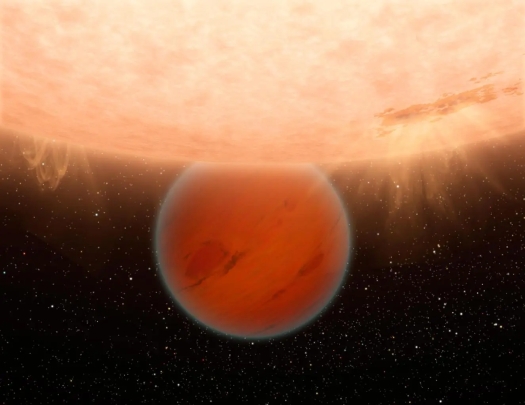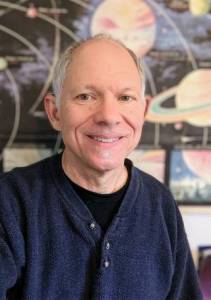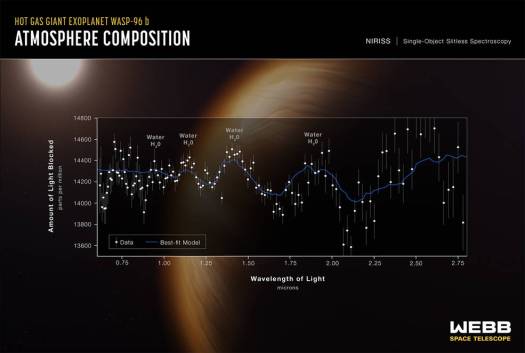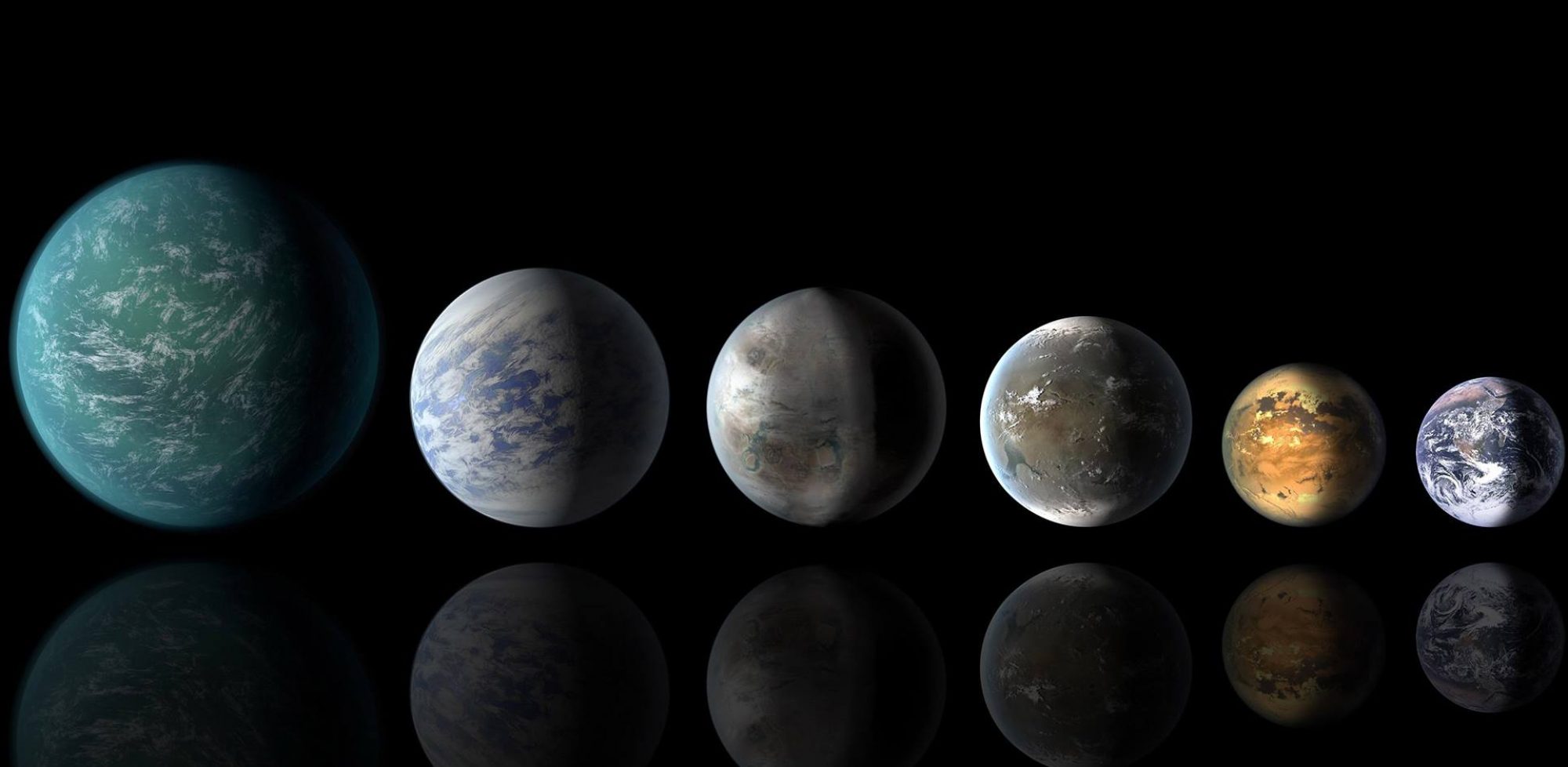
The James Webb Space Telescope has begun the part of its mission to study the atmospheres of 70 exoplanets in ways, and at a depth, well beyond anything done so far.
The telescope is not likely to answer questions like whether there is life on distant planet — its infrared wavelengths will tell us about the presence of many chemicals in exoplanet atmospheres but little about the presence of the element most important to life on Earth, oxygen.
But it is nonetheless undertaking a broad study of many well-known exoplanets and is likely to produce many tantalizing results and suggest answers to central questions about exoplanets and their solar systems.
Many Worlds has earlier looked at the JWST “early release” program, under which groups are allocated user time on the telescope under the condition that they make their data public quickly. That way other teams can understand better how JWST works and what might be possible.
Another program gives time to scientists who worked on the JWST mission and on its many instruments. They are given guaranteed time as part of their work making JWST as innovative and capable as it is.
One of the scientist in this “guaranteed time observations program” is Thomas Greene, an astrophysicist at NASA Ames Research Center. The groups he leads have been given 215 hours of observing time for this first year (or more) of Cycle 1 of JWST due to his many contributions to the JWST mission as well as his history of accomplishments.
In a conversation with Greene, I got a good sense of what he hopes to find and his delight at the opportunity. After all, he said, he has worked on the JWST idea and then mission since 1997.
“We will be observing a diverse sample of exoplanets to understand more about them and their characteristics,” Greene said. “Our goal is to get a better understanding of how exoplanets are similar to and different from those in our solar system.”
And the JWST spectra will tell them about the chemistry, the composition and the thermal conditions on those exoplanets, leading to insights into how they formed, diversified and evolved into planets often so unlike our own.

The JWST was initial conceived and designed to look with far greater power than any telescope before at the earliest times of the universe and the first stars and galaxies. It took on additional goals regarding how galaxies evolve and what happens when stars and planets are born today.
The exoplanet side of the JWST program did not exist until rather late in its development, but now it will use roughly 25 percent of its observing time.
The selection of exoplanets to be studied by Greene and others in this Cycle 1 of JWST observing will more specifically look at these key issues, some of the major questions and possibilities as seen by Greene:
• So far, no solar system discovered is similar (or even close) to our solar system. Similar systems may be discovered in time, but for now the issue is that ours looks unique. The question is why? What makes planets form where and how they do in other systems?

• The most common planets discovered so far are of a size and type not found in our solar system. These are super-Earth and sub-Neptune size planets and they are most everywhere, except in our system. Again, a puzzle.
• Do many planets have atmospheres and if so what chemicals are found in them? Especially for the rocky planets that might be habitable, the question is whether flaring from their suns strips off their atmospheres and makes them essentially sterile. And if a planet is stripped of its atmosphere, can a new one be formed from magma and gases coming from the planet interiors?
• One important way to determine if a planet supports life is to look for chemicals that are not in equilibrium. On Earth, for instance, oxygen is an element that bonds very quickly with other elements and compounds and so it has to be constantly resupplied (largely by plants) to keep an atmosphere with 21 percent oxygen. Some other chemical disequilibrium has been identified on exoplanets and scientist want to understand how and why they exist.
• Will JWST, which sees in infrared wavelengths, be able to cut through the clouds and hazes that seem to surround many exoplanets? If the telescope can pierce the haze cover, then scientists will be able to much better study and understand the atmospheres below the hazes for many more exoplanets.
Almost all of the planets that will be observed during Cycle 1 of JWST viewing by Greene and others will be large: super-Earths and sub-Neptunes, ice giants, giant gas planets like Jupiter and larger and planets orbiting very close to their suns. In other words, they are not candidates for being habitable planets.
The one exception is the rocky planets of the Trappist-1 system, which has seven terrestrial planets orbiting close to red dwarf star, and they will all get a good look during Cycle 1.
Trappist-1c has already been observed as well as a number of planets during observatory commissioning and the Early Release science program. Greene said that papers are already being written about what they have found.

The Webb telescope does not do the kind of direct imaging that will produce resolved exoplanet images, but it can perform direct imaging on large planets far from their host stars. So instead of producing the kind of exoplanet images that future telescopes may be able to send back, JWST can study exoplanets via direct imaging by collecting spectra of light passing through the planet’s atmospheres as they transit.
In that way the observatory can collect signatures of particular elements and compounds known to appear at certain locations of the light spectrum. In recent years, exoplanet scientists have also learned to use the transit eclipse technique as well, where the atmosphere of an exoplanet is analyzed by measuring what is lost to the observer in terms of heat and chemicals when the exoplanet passes behind its star.
While this world of transit spectroscopy of atmospheres is the focus of JWST exoplanet study, it’s worthwhile to remember that the population of transiting exoplanets is less than 1 percent of the planets inferred to be out there. There needs to be a special geometry between the telescope, the planet and the star to make the transits at all detectable.
JWST will not be searching for signs of life, but it will studying exoplanet atmospheres and their composition and that presents the opportunity for surprises. Especially as the use of the telescope becomes more sophisticated over the years, however, it will be focusing more on smaller and rocky planets and on finding a planet that is deemed “habitable” on some level is certainly a possibility.

Credits: NASA, ESA, and R. Hurt (IPAC/Caltech)
Greene has played an unusual set of roles with the Webb telescope as an inventor/engineer, an observing scientist and a manager of sorts.
He says he always liked to build things and spent some of his early adulthood designing instruments at Lockheed Martin. It was in that period that he responded to an opportunity to bid on an instrument that would go on what became the JWST. His 1997 bid was accepted — conceived with some former colleagues at the University of Arizona (including principal investigator Marcia Rieke, a regents professor at the school and designer of other instruments for other missions) and the engineers at Lockheed Martin.
Greene worked long and hard on an imager and spectrometer that became the Near Infrared Camera or NIRCam. He reported that NIRCam has been the workhorse of the JWST so far, especially during the commissioning stage.
The NIRCam is the primary imaging instrument of the JWST, with an internal coronograph to block out sunlight that would otherwise keep the telescope from seeing planets near stars. It also has an Optical Telescope Element wavefront sensor, which provides something similar to instant LASIK vision correction.
Greene has also been deeply involved with the Mid-Infrared Instrument (MIRI), which has both a camera and a spectrograph that sees light in the mid-infrared, with wavelengths that are longer than our eyes see.

MIRI is the work of a group of scientists and engineers from ten European countries, a team from the Jet Propulsion Lab in California, and scientists (including Greene) from several U.S. institutions.
Greene is a co-investigator for both NIRCam and MIRI.
He is also on the JWST Users Committee at the Space Telescope Science Institute at Johns Hopkins University, which oversees the on-going operations of the observatory and selects which of the many scientists requesting telescope time will get it and how much.
Because of his work on the JWST instruments, Greene and his teams have unusual 215 hours of Cycle 1 telescope time to observe nine exoplanets — from the small and rocky Trappist-1b to super-Earths and sub-Neptunes, and to a massive hot Jupiter planet.
His first team observing run was supposed to be this past Sunday. But he got word soon before that the observing run had to be rescheduled until some months in the future. Such are the exigencies of observing with a new Grand Observatory.
Fortunately, his team has a observing different run scheduled for September.
